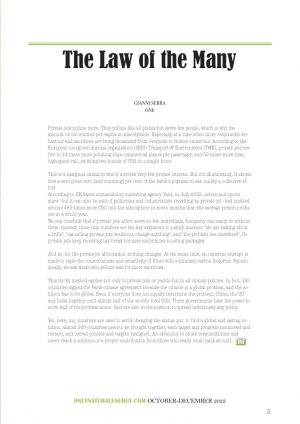 Private jets pollute more. They pollute like all planes but serve few people, which is why the amount of co2 emitted per capita is unacceptable. Especially at a time when more responsible behaviour and sacrifices are being demanded from everyone to reduce emissions. According to the European non-governmental organisation (NGO) Transport & Environment (T&E), private jets are five to 14 times more polluting than commercial planes per passenger, and 50 times more than high-speed rail, emitting two tonnes of CO2 in a single hour.
Private jets pollute more. They pollute like all planes but serve few people, which is why the amount of co2 emitted per capita is unacceptable. Especially at a time when more responsible behaviour and sacrifices are being demanded from everyone to reduce emissions. According to the European non-governmental organisation (NGO) Transport & Environment (T&E), private jets are five to 14 times more polluting than commercial planes per passenger, and 50 times more than high-speed rail, emitting two tonnes of CO2 in a single hour.
This is a marginal situation which involves very few private citizens. But it’s illuminating. It shows how a zero point zero [and counting] per cent of the earth’s population can nullify a collective effort.
According to UK-based sustainability marketing agency Yard, in July 2022, actors and sports stars – but it can also be said of politicians and industrialists travelling by private jet – had emitted around 483 times more CO2 into the atmosphere in seven months than the average person produces in a whole year.
We can conclude that if private jets affect serve so few individuals, humanity can easily do without them. Instead, those tiny numbers are the key argument to justify inaction: “we are talking about a trifle”, “cancelling private jets would not change anything”, and “the problem lies elsewhere”. So private jets keep receiving tax break bonuses and similar boosting packages.
And so, for the private-jet aficionados, nothing changes. At the same time, an insistent attempt is made to raise the consciousness and sensitivity of those with a minimal carbon footprint. Paradoxically, we ask those who pollute less for more sacrifices.
This tricky method applies not only to private jets or yachts but to all climate policies. In fact, 195 countries signed the Paris climate agreement because the climate is a global problem, and the solution has to be global. Even if everyone does not equally determine the problem, China, the US and India together emit almost half of the world’s total CO2. Three governments have the power to solve half of the problem alone. And are also in the position to spread infectiously any policy.
Yet, here, too, numbers are used to avoid changing the status quo: to find a global and lasting solution, almost 200 countries need to be brought together, each target and progress monitored and revised, and overall policies and targets realigned. An ideal ploy to dilute responsibilities and never reach a solution or a proper contribution from those who really could (and should).
Gianni Serra




